Thakali people
Thakali people are an ethnolinguistic group originating from the Thak Khola region of Mustang District in the Dhaulagiri zone of Nepal. Thak-sat-se is the traditional area of the Thakali community, which lies in the salt-trading zone on the south of Tukuche mountain, the valley of the Kali Gandaki river in western Nepal.[1] According to the 2001 census, Thakali population of around 12,973 constituted only 0.06% of Nepal's population. As per the 2011 Nepal census, there are 13,215 Thakali people in Nepal.[2]
Thakalis are some of Nepal's most successful business people. They trade in places like Tukuche and Thaksatse. Thakalis were classified according to the place of Mustang they came from. They are owners of Nepal's hotels and motels. However, due to extensive trade all over Nepal, Sikkim, Bhutan and Tibet, many Thakalis have resettled in Pokhara, Kathmandu and in southern Nepal. A good number of Thakalis are in Japan and England these days. Thakalis outside their homeland follow a distinct form of Tibetan Buddhism, while Thakalis in southern Nepal practice Buddhism with bit of Hindu flavor. Those in Mustang remain much more traditionally Buddhist.[3]. Thakalis have their own Thakali language and their own culture with distinct rituals during birth, marriage and death.
Thakalis are very organized people. They have neat kitchens and keep tidy houses. Lhafewa (Bar Barse Kumbha Mela), Tornala (ancestral worship) and Falo (Kumar Yatra) are the major festivals of Thakalis. Dhnom is the title of the Thakali priest who performs the work of the local shaman. Madaal, Khaprang and Thamken are their main musical instruments.
References
- Stefan Georg (1996). Marphatan Thakali. Untersuchungen zur Sprache des Dorfes Marpha im Oberen Kali-Gandaki-Tal/Nepal. München: LINCOM EUROPA. ISBN 3895860980.
- "National Population and Housing Census 2011" (PDF). Central Bureau of Statistics, Government of Nepal. Retrieved 2019-05-03.
- Michael Vinding (1998). The Thakali: A Himalayan Ethnography. Serindia Publications, Inc. ISBN 9788187392811.
See also
External links
- "The Thak Archive". Digital Himalaya. Retrieved 2014-06-09.
